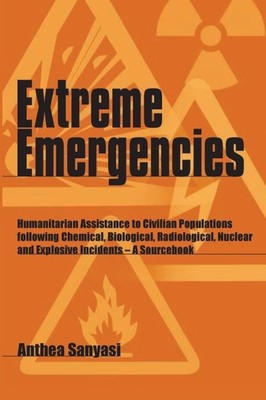
- We will send in 10–14 business days.
- Author: Anthea Sanyasi
- Publisher: ITDG Publishing
- ISBN-10: 1853396028
- ISBN-13: 9781853396021
- Format: 23.4 x 15.8 x 1.6 cm, minkšti viršeliai
- Language: English
- SAVE -10% with code: EXTRA
Reviews
Description
This comprehensive and detailed sourcebook offers humanitarian organizations, for the first time, essential information on how to prepare for the key man-made disasters which they have to face in an ever more dangerous world.
The possibility of a chemical, biological, radiological, nuclear or enhanced explosive (CBRNE) disaster has never been greater. Extreme Emergencies will be an essential tool in helping agencies plan and prepare for the worst case.
Researched by staff from the UK medical relief agency Merlin, the book draws together key international expertise and experience. It explains emergency planning, management and safety issues; gives guidance on the range of hazards, their characteristics, clinical effects and required treatment; and offers detailed resource information on equipment, training issues and relevant support organizations.
Preface. Acknowledgements. List of figures, boxes and tables. List of acronyms.
INTRODUCTION
CBRNE - A new security risk. Past and current events of CBRNE catastrophic incidents. Enhancing awareness and preparedness for CBRNE incidents. Potential role of humanitarian aid organizations. Introduction to the Sourcebook
PART I - MANAGING THE CRISIS
STRATEGIC MANAGEMENT: NGO objectives; Key considerations; Key policy issues at headquarter and field levels; Personnel issues - protection of front line staff; Disaster Management Strategy.
TACTICAL MANAGEMENT: Field operation vulnerabilities; Hazard vulnerability analysis and risk reduction measures; Threat assessment and risk policy strategy; Horizon scanning, surveillance and advisory mechanisms; Risk management tools; Information coordination mechanisms.
FIELD STAFF SAFETY: Incident emergency response; Risk assessment and staff safety; Creation of a safe room; Re-entry; Individual emergency decontamination.
OPERATIONAL MANAGEMENT: Planning assumptions; Field response procedures; The incident response phase; Incident response procedures; Zones for emergency response operations; Medical assistance and casualty management; Humanitarian relief and assistance; NGO operation management actions; Disaster relief priorities; Humanitarian organization coordination.
PSYCHOSOCIAL SUPPORT: Chemical and biological threat; Post attack; Syndromes; Staff care; Mental health interventions.
PART II - HAZARDS: CBRNE hazards; Key chemical agents; Key biological agents; Radiation and nuclear incidents; Explosive incidents
PART III - RESOURCES: Detection and monitoring devices; Personal protection equipment; Medical countermeasures; Medical protocols for key chemical agents; Decontamination procedures; Medical protocols for key biological agents; Civil nuclear site incidents; Training and capacity building; Directory of organizations and conventions; Quick reference cards.
References. Internet references and CBRNE related links. Endnotes. Glossary. Index.
EXTRA 10 % discount with code: EXTRA
The promotion ends in 21d.23:14:26
The discount code is valid when purchasing from 10 €. Discounts do not stack.
- Author: Anthea Sanyasi
- Publisher: ITDG Publishing
- ISBN-10: 1853396028
- ISBN-13: 9781853396021
- Format: 23.4 x 15.8 x 1.6 cm, minkšti viršeliai
- Language: English English
This comprehensive and detailed sourcebook offers humanitarian organizations, for the first time, essential information on how to prepare for the key man-made disasters which they have to face in an ever more dangerous world.
The possibility of a chemical, biological, radiological, nuclear or enhanced explosive (CBRNE) disaster has never been greater. Extreme Emergencies will be an essential tool in helping agencies plan and prepare for the worst case.
Researched by staff from the UK medical relief agency Merlin, the book draws together key international expertise and experience. It explains emergency planning, management and safety issues; gives guidance on the range of hazards, their characteristics, clinical effects and required treatment; and offers detailed resource information on equipment, training issues and relevant support organizations.
Preface. Acknowledgements. List of figures, boxes and tables. List of acronyms.
INTRODUCTION
CBRNE - A new security risk. Past and current events of CBRNE catastrophic incidents. Enhancing awareness and preparedness for CBRNE incidents. Potential role of humanitarian aid organizations. Introduction to the Sourcebook
PART I - MANAGING THE CRISIS
STRATEGIC MANAGEMENT: NGO objectives; Key considerations; Key policy issues at headquarter and field levels; Personnel issues - protection of front line staff; Disaster Management Strategy.
TACTICAL MANAGEMENT: Field operation vulnerabilities; Hazard vulnerability analysis and risk reduction measures; Threat assessment and risk policy strategy; Horizon scanning, surveillance and advisory mechanisms; Risk management tools; Information coordination mechanisms.
FIELD STAFF SAFETY: Incident emergency response; Risk assessment and staff safety; Creation of a safe room; Re-entry; Individual emergency decontamination.
OPERATIONAL MANAGEMENT: Planning assumptions; Field response procedures; The incident response phase; Incident response procedures; Zones for emergency response operations; Medical assistance and casualty management; Humanitarian relief and assistance; NGO operation management actions; Disaster relief priorities; Humanitarian organization coordination.
PSYCHOSOCIAL SUPPORT: Chemical and biological threat; Post attack; Syndromes; Staff care; Mental health interventions.
PART II - HAZARDS: CBRNE hazards; Key chemical agents; Key biological agents; Radiation and nuclear incidents; Explosive incidents
PART III - RESOURCES: Detection and monitoring devices; Personal protection equipment; Medical countermeasures; Medical protocols for key chemical agents; Decontamination procedures; Medical protocols for key biological agents; Civil nuclear site incidents; Training and capacity building; Directory of organizations and conventions; Quick reference cards.
References. Internet references and CBRNE related links. Endnotes. Glossary. Index.


Reviews